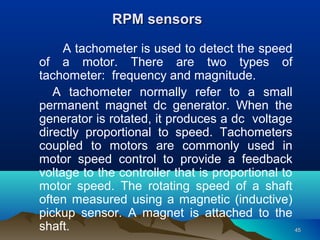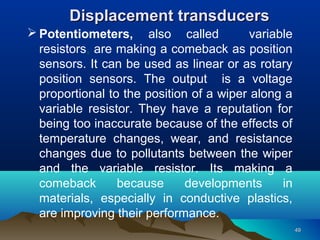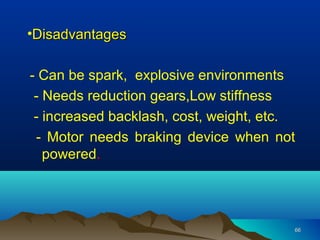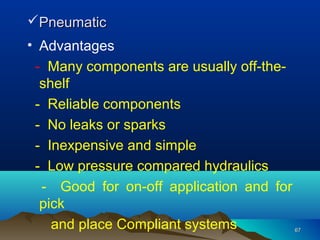Chapter 3 automation devices
- 1. 11 CHAPTER 3CHAPTER 3 AUTOMATION DEVICES
- 2. 22 3.1 Introducton3.1 Introducton • Automation includes sensors, switches, actuators, transducers and controllers
- 3. 33 SwitchesSwitches Switches are frequently items in many electrical actuation systems. Switches make or break connections in an electrical circuit. This may be to switch on electric motors, switch on heating elements, actuate solenoid valves controlling hydraulic or pneumatic cylinders, control a set of sequential actions , etc.
- 5. 55 Dual in-line Package (DIP) SwitchSlide Switch
- 6. 66
- 7. 77 Mechanically Operated SwitchesMechanically Operated Switches A mechanically operated switch is one that is controlled automatically by factors such as pressure, position and temperature. Examples of mechanically operated switches are such as limit switch, micro switch, temperature switch, pressure switch and level switch
- 8. 88 SensorsSensors Sensor is used for an element, which produces a signal relating to the quality being measured. Sensors are devices that are used to detect and some time to measure. They are types of a transducer.
- 9. 99 Specification and Selection of a SensorSpecification and Selection of a Sensor Range and span Range and linearity error in a temperature sensor
- 10. 1010 Repeatability Sensor’s repeatability indicate the range of output that the user can expect when the sensor measures the same input values several time On other hand its mean the ability to give the same output for repeated application of the same input value.
- 11. 1111 Linearity Linearity often quoted on spec sheets as a +/- value for the sensor’s output signal. Pressure
- 12. 1212 Accuracy The extent which the value indicated by a measurement system might be wrong. Sensitivity The relationship indicating how much output to get per unit input. Stability The ability to give the same output when used to measure a constant input over a period of time.
- 13. 1313 Proximity SensorProximity Sensor Proximity sensors or switches are pilot devices that detect the presence of object or target without physical contact Proximity sensors are used when: required, as in counting or ejection control applications. The object being detected is too small, too lightweight, or too soft to operate a mechanical switch.
- 14. 1414 An object has to be sensed through non- metallic barriers such as glass, plastic, and paper cartons. Hostile environments demand improved sealing properties, preventing proper operation of mechanical switches. Long life and reliable service are required. A fast electronic control system requires a bounce-free input signal.
- 15. 1515 Type of Proximity sensorsType of Proximity sensors Inductive proximity sensor It is most widely used due to its small size, robustness and low cost. An inductive proximity sensor is a sensing device that is actuated by a metal object.
- 16. 1616
- 17. 1717 When energy is supplied, the oscillator operates to generate a high frequency field. When a metal object enters the high frequency field, eddy currents are induced in the surface of the target. This results in a loss of energy in the oscillator circuit; consequently this causes a smaller amplitude of oscillator. The detector circuit recognizes a specific change in amplitude and generate a signal that will turn the solid state output on or off. When metal object leaves the sensing area, the oscillator regenerates allowings the sensor to return to its normal state.
- 18. 1818 Capacitive proximity sensor It is a sensing device that is actuated by conductive and non-conductive materials. Capacitive proximity sensor
- 19. 1919 The operation of capacitive sensor is also based on principle of an oscillator. Inside the sensor is a circuit that uses the supplied DC power to generate AC, to measure the current in the internal AC circuit, and to switch the output circuit when the amount of AC current changes. Capacitors can hold a charge because, when one plate is charged positively, negative charges are attracted into the other plate, thus allowing even more positive charges to be introduced into the first plate. Unless both plates are present and close to each other, it is very difficult to cause either plate to take on very much charge.
- 20. 2020 Another type of a capacitive sensor is formed by two metallic electrodes which are placed in the feedback loop of a high frequency oscillator that is inactive with no target present. As the target approaches the face of the sensor, it enters the electrostatic field that is formed by the electrodes. This causes an increase in the coupling capacitance and the circuit begins to oscillate.
- 21. 2121
- 22. 2222 Optical proximity sensor (LightOptical proximity sensor (Light sensor/photoelectric sensor)sensor/photoelectric sensor)
- 23. 2323 They are widely used in automated systems. These sensors are commonly known as light beam sensors of the thru-beam and retro- reflective types. Thru-beam type is usually used to signal the presence of an object that block light. The retro-reflective type has the transmitter and receiver in the same package. It detect targets that reflect light back to the sensor.
- 24. 2424 Magnetic SwitchesMagnetic Switches A magnetic switch (also called reed relay) contact is composed of two flat contact tabs that are hermetically sealed (airtight) in a glass tube filled with protective gas. As a permanent magnet approaches, the ends of the overlapped contact tabs attract one another come into contact and demagnetizes and return to it original position when the permanent magnet is moved.
- 25. 2525
- 26. 2626 Bar code technologyBar code technology It is widely implemented in industry and supermarket. Bar code system consists of three basic elements; bar code symbols, scanner and decoder. Bar code symbol composed of bars and spaces of varying with, provides a means of expression for human readable characters in a form (bars and spaces) readable by machines. Bar code symbols require a ‘quite zone’ of no mark in front of the black marks. The code itself contains coded data between start and stop patterns. Both the width of dark and light areas are significant.
- 27. 2727
- 28. 2828 The name bar code reader or scanner designates the optical reading instrument capable of emitting and collecting a coherent (laser) or non coherent (LED) red, intermediate or infrared beam. A bar code reader is a computerized system and which is build around retro-reflective optical sensors. Bar code reader explore symbols (bar codes) by shedding light across them and collecting the reflected beam with an optical transducer (photo detector) / converting a invisible electromagnetic wave into an analogical electric signal. Some bar code readers can sweep a target area hundred of times a second.
- 29. 2929
- 30. 3030 A decoder is an electronic circuit needed to transform this signal into digital form (succession of ones and zeros in the form of pulses) corresponds 100 percent to the programmed bar code . Benefits of the bar code system The single item ID from primary production sources to consumers, thus avoiding alterations and errors. Precise information on production times and cycles, inspection, storing, transportation and sales.
- 31. 3131 General statistical data. Minimum data error owing to auto check system and control characters. Vertical oversize that allows a code to be scanned even if, as a result of damage, only a small part of its total height can be read. Faster, more efficient reception, sale and collection, particularly at supermarket checkout counters. No more price remarking or item by item relabelling, especially in countries with high inflation. Prompt information on stock, sales and supplies.
- 32. 3232 Human error elimination in marking, interpreting, invoice preparation and unknown loss. Adaptable to most packing and printing system and exciting packaging materials and techniques. Easily adaptable and compatible with most available computer brands and systems. Human error elimination in marking, interpreting, invoice preparation and unknown loss. Adaptable to most packing and printing system and exciting packaging materials and techniques. Easily adaptable and compatible with most
- 33. 3333 Temperature sensorsTemperature sensors Thermocouple A thermocouple consists essentially of a pair of dissimilar conductors welded or fused together at one end to form the "hot" or measuring junction, with the free ends available for connection to the "cold" or reference junction. A temperature difference between the measuring and reference junctions must exist for this device to function as a thermocouple. When this occurs, a small dc voltage is generated. Thermocouples, because of their rugged-ness and wide temperature range, are used in industry to monitor and control oven and furnace
- 34. 3434 A reference junction is required for measuring temperature with thermocouples. The out-put voltage of a thermocouple is approximately proportional to the temperature difference in voltage between the measuring (hot) junction and the reference (cold) junction.
- 35. 3535
- 36. 3636 Resistance temperature detectors (RTDs)Resistance temperature detectors (RTDs) The basic concept underlying the measurement of temperature by resistance temperature detectors (RTDs) is that the electrical resistance of metals varies proportionally with temperature. This proportional variation is precise and repeatable, therefore allowing the consistent measurement of temperature through electrical resistance detection. Platinum is the material most often used in RTDs because of its superiority regarding temperature limit, linearity, stability, and reproducibility.
- 37. 3737
- 38. 3838 ThermistorThermistor A thermistor is a thermally sensitive resistor that usually has a negative temperature coefficient. As the temperature increases, the thermistor's resistance decreases, and vice versa. Thermistors are very sensitive (as much as 5 percent resistance change per °C); therefore, they are capable of detecting minute changes in temperature. Their sensing area is small, and their low mass allows a fairly fast response time of measurement. They are available in a variety of sizes and styles. Because of the large voltage output produced by a typical thermistor bridge amplification is normally unnecessary. The thermistor sensing unit is
- 39. 3939
- 40. 4040
- 41. 4141 Encoder sensorsEncoder sensors An encoder is used to convert linear or rotary into a digital signal. There are two types of encoder sensors: i. Incremental encoder The optical-type incremental is a rotary encoder, creates a series of square waves as its shaft is rotated. The encoder disk interrupts the light as the encoder shaft is rotated to produce the square wave output waveform. It is very sensitive and accurate (normally from 100 to 4000 pulses per revolution).
- 42. 4242 ii. The optical type absolute rotaryii. The optical type absolute rotary encoderencoder The optical-type absolute is also a rotary encoder, operates in the same manner with the exception that more traces have been applied to the encoder disk. When scanned in a parallel fashion, these traces provide angle information in the form of code. The number of traces corresponds to he number of steps per rotation. The traces are arranged in Gray code. The Gray coding has the advantage over other coding in that only one bit (trace) is changed per step. This helps avoid misreading. The number of square waves obtained from the output of the encoder can be made to correspond to the mechanical movement required.
- 43. 4343
- 44. 4444
- 45. 4545 A tachometer is used to detect the speed of a motor. There are two types of tachometer: frequency and magnitude. A tachometer normally refer to a small permanent magnet dc generator. When the generator is rotated, it produces a dc voltage directly proportional to speed. Tachometers coupled to motors are commonly used in motor speed control to provide a feedback voltage to the controller that is proportional to motor speed. The rotating speed of a shaft often measured using a magnetic (inductive) pickup sensor. A magnet is attached to the shaft. RPM sensorsRPM sensors
- 46. 4646 A small coil of wire held near the magnet receives a pulse each time the magnet passes. By measuring the frequency of pulses, the shaft speed can be determined. The voltage output of a typical pick up coil is quite small and requires amplification.
- 47. 4747
- 48. 4848 TransducerTransducer A transducer is any device that converts energy from one form to another. Transducer can be divided into to: i/p transducer and o/p transducer. For e.g. electric i/p transducer convert non-electric energy such as sound, light into electric energy. Electric o/p transducer works in the reverse order-convert electric energy to forms of non-electric energy
- 49. 4949 Displacement transducersDisplacement transducers Potentiometers, also called variable resistors, are making a comeback as position sensors. It can be used as linear or as rotary position sensors. The output is a voltage proportional to the position of a wiper along a variable resistor. They have a reputation for being too inaccurate because of the effects of temperature changes, wear, and resistance changes due to pollutants between the wiper and the variable resistor. Its making a comeback because developments in materials, especially in conductive plastics, are improving their performance.
- 50. 5050
- 51. 5151 Linear variable differential transformerLinear variable differential transformer (LVDT)(LVDT) It is basically a transformer with a movable core and two secondary windings. LVDT sensor can be used to control the water level in a tank . especially in conductive plastics, are improving their performance. The LVDT is provided with AC at its central (input) coil.
- 52. 5252
- 53. 5353 CapacitiveCapacitive Position SensorsPosition Sensors Have been used as dial position sensors in radios for years. (Their variable capacitance is used in the radio frequency selection circuitry, so perhaps calling them "sensors" in this application isn't quite right.) A capacitor increases in capacitance as the surface area of the plates facing each other increases. If one 180 degree set of plates is attached to a rotating shaft, and another 180 degree set of plates is held stationary, then capacitance increases linearly with shaft rotation through 180 degrees.
- 54. 5454 Capacitive sensors are used in a slightly different way to detect the height of fluids that have higher dielectric constraints than air. If the fluid rises in the capacitive height sensor, then more surface area of the capacitor plates are coupled by the fluid, and capacitance rises proportionally with fluid height.
- 55. 5555
- 56. 5656 Force and pressure transducerForce and pressure transducer Strain gauge It is a sensor that measure deformation due to pressure. When the strain gauge is stretched, the conductor reduces its cross- sectional area and thus can carry less current. The piezoelectric strain gauge sensor includes a crystalline material that develops a voltage across the crystal when the crystal is deformed. A strain wire gauge transducer converts a mechanical strain into an electric signal. The force applied to the gauge causes the gauge to bend. This bending action also distorts the physical size of the gauge, which, in turn, changes its resistance
- 57. 5757
- 58. 5858 Flow transducers/SensorFlow transducers/Sensor Pitot (pea-toe) type Pressure upstream from a restricted orifice in a pipe is always higher than pressure downstream from that restricted. The greater the flow rate, the greater the pressure difference. If a differential pressure sensor compares pressures before and after restriction, then flow rate can be determined
- 59. 5959 Turbine typeTurbine type The blades of turbine flow meter are often magnetized, so that a magnetic sensor outside the pipe can detect the rotation speed of the turbine. Although the output rotation speed of this flowmeter is theoretically proportional to the flow rate, several factors such leaking, viscosity of fluid, etc can effect the precision.
- 60. 6060 Vortex sheddingVortex shedding A Vortex shedder obstruction creates swirling areas of low pressure behind and on side of the obstruction as fluid flows past. The faster the fluid flow, the faster this vortex is created and destroyed. A vibration sensor on the obstruction measures the frequency at which the obstruction vibrates as the vortex location alternates from one side to the other.
- 61. 6161
- 62. 6262 ActuatorActuator Actuation systems are the elements of control systems which are responsible for transforming the output of a microprocessor or control system into a controlling action on a machine or device. E.g. we might have an electrical output of the controller which has to be transformed into a linear motion to move a load.
- 63. 6363 Comparison of actuating systemsComparison of actuating systems Hydraulic • Advantages - Good for large robots and heavy payload - Highest power/weight ratio - Stiff system, high accuracy, better response - No reduction gear needed - Can work in wide range of speeds without difficulty - Can be left in position with out any damage
- 64. 6464 •DisadvantagesDisadvantages - May leak. Not fit for clean room applications - Requires pump, reservoir, motor, hoses, etc. - Can be expensive and noisy. - Requires maintenance - Viscosity of oil changes with temperature - Very susceptible to dirt and other foreign material in oil - High torque, high pressure, large inertia on the actuator
- 65. 6565 ElectricalElectrical • Advantages - Good for all sizes of robots - Better control, good for high precision robots - Higher compliance than hydraulics - Reduction gears used re duce inertia on the motor - Does not leak, good for clean room - Reliable, low maintenance
- 66. 6666 •DisadvantagesDisadvantages - Can be spark, explosive environments - Needs reduction gears,Low stiffness - increased backlash, cost, weight, etc. - Motor needs braking device when not powered.
- 67. 6767 PneumaticPneumatic • Advantages - Many components are usually off-the- shelf - Reliable components - No leaks or sparks - Inexpensive and simple - Low pressure compared hydraulics - Good for on-off application and for pick and place Compliant systems
- 68. 6868 •DisadvantagesDisadvantages - Noisy systems - Require air pressure, filter. etc. - Difficult to control their linear position - Deform under load constantly - Very low stiffness. Inaccurate response - Lowest power to weight ratio
- 71. 7171 Directional Control ValvesDirectional Control Valves Pneumatic and hydraulic systems use directional control valve to direct the flow of fluid through a system. It is used to open/close , or on/off devices. These valves are used to develop sequences control systems. They can be activated to switch the fluid flow direction of mechanical, electrical or fluid pressure signals. Figure 4.3(a) shows a typical directional control valve (spool valve). In (a) the air supply is connected to port 1 and port 3 is closed. This will make the device connected to port2 is pressurized. In (b) the air supply is cut off and port 2 is connected to port 3.
- 73. 7373 Another type of directional control valve, the poppet valve. There is no connection between port 1 to which the system is connected. When the button is released the spring forces the ball back up against its seat and so closes off the flow.
- 74. 7474 (a) Flow path, (b) flow shut off, (c) initial connections
- 76. 7676
- 77. 7777 CylinderCylinder a) A Double acting cylinder b) Single acting cylinder
- 78. 7878 • The hydraulic or pneumatic cylinder is an example of a linear actuator. The principle and form are the same for both hydraulic and pneumatic with the difference of size and pressures(hydraulic requires more pressure). The cylinder consist of a cylindrical tube along which a piston/ram can slide. Single acting cylinder is used when the control pressure is applied to just one side of the piston, a spring often being used to provide the opposition to the movement of the piston. When a current passes through the solenoid, the valve switches position and pressure is applied to move the piston along the cylinder. As a consequence the spring returns the piston back to initial position.
- 79. 7979 Control of Single acting cylinder
- 80. 8080 • Double acting cylinder is used when the control pressures are applied to each side of the piston. A difference in pressure between the two sides then results in motion of the piston, the piston being able to move in either direction along the cylinder as result of high pressure signals.
- 81. 8181 Control of Double acting cylinder
- 82. 8282 Figure below shows how a 4/3 way directional control valve controls a double acting cylinder
- 83. 8383 Relay • is an electrically operated device that mechanically switches electric circuits. It is an important part of many control system because it is useful for remote control and for controlling high voltage and current devices with a low voltage and current control signal. When current flows through the electromagnet in an electromechanical control relay, a magnetic field that attracts the iron arm of the armature to the core of the magnet is set up. As a result, the contacts on the armature and relay frame are switched. Relay may have NO contacts or NC contacts or combinations of
- 84. 8484 An electromechanical control relay
- 85. 8585 Solenoid • is a device used to convert an electrical signal or an electrical current into linear mechanical motion. The solenoid is made up of a coil with a movable iron core. When the coil is energized, the core, or armature as it is sometimes called, is pulled inside the coil. The amount of pulling or pushing force produced by the solenoid is determined by the number of turns of copper wire and the amount of current flowing through the coil.
- 86. 8686 A solenoid valve is a combination of two basic functional units. A solenoid (electromagnet) with its core or plunger. • A valve body containing an orifice in which a disc or plug is positioned to restrict or allow flow. • Flow through an orifice is off or allowed by the movement of the core and depends on whether the solenoid is energized or de- energized. When the coil is energized, the core is drawn into the solenoid coil to open the valve. The spring returns the valve to its original closed position when the current ceases. Solenoid valves are available to control hydraulics (oil fluid), pneumatics (air),























































































